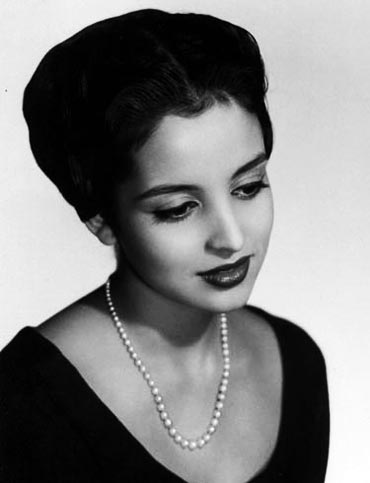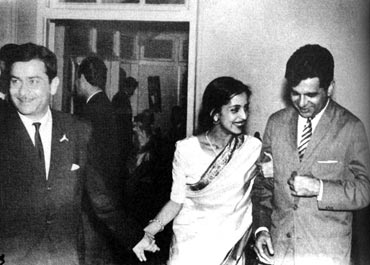Vogue called Leela Naidu one of the most beautiful women in the world; Salvador Dali used her as a model for the Madonna.
But she is much more than a hauntingly beautiful face, much more than an actor.
In Leela: A Patchwork Life the late actor shared her amazing story.
My film career began with three frames that remained on a roll of photographic film.
Kamala Chakraborty, the widow of Ameya Chakraborty, had been shooting textiles or handicrafts as apart of the work she did with Pupul Jaykar.
Then she came to visit us at Sujan Singh Park and since she had three frames left, she used them to take pictures of me.
Excerpted with the publisher's permission from Leela: A Patchwork Life by Jerry Pinto published by Penguin Books India.
'Oh God, not another socialite'
Image: Tilak Raj Oberoi, Leela Naidu and their twin daughters, Maya and PriyaAnd those were the prints that were lying on the table when Hrishikesh Mukherjee went to visit her. He took one look at them, so she told me, and said, 'She is my Anuradha.'
Then he asked, 'Who is she?'
Kamala told him that I was married to Tikki Oberoi.
'Oh God, not another socialite,' he said.
Kamala roundly castigated him for making generalisations. Perhaps that was why he had to work on her a little before she would give him any further details.
When she called me to prepare me, she told me she had tried to dissuade him, telling him that I was not really interested in Hindi films.
That set him back a bit. For like all inhabitants of hermetic, self-involved worlds, the denizens of Hindi cinema cannot believe that there can be others unmoved by its tinsel attractions.
'To a peeping face in a moving car'
Image: Raj Kapoor, Leela Naidu and Dilip Kumar'How do you know? He asked.
'She turned down Raj Kapoor and he wanted to sign her for four films.'
That was true.
In 1955, when we returned to India from Europe, we lived in Bombay as the guests of Dr and Mrs Baliga. During our stay, the good doctor asked me if I would like to accompany them to a wedding. I agreed because he assured me there would be Jalebis. (Hot Jalebis without chemical dyes in them were one of my favorites.)
'Wear a sari,' I was told. Doctors can be quite autocratic. But then most men can, given half the chance. I got into an orange Benaresi silk sari with delicate zari on it and put my hair up in a bun and got into the car that whisked us off to Matunga.
It was only when I got down from the car that I realized that it was a filmi wedding. I did my namastes to a series of portly gentlemen.
Later, Mrs Baliga told me that I had smiled politely and walked past two generations of Hindi cinema aristocracy: Prithiviraj Kapoor and Raj Kapoor were at the doors, welcoming guests to Shammi Kapoor's wedding. That was where Raj Kapoor saw me the first time. He later made enquiries with the Baligas and was told that I was in Delhi.
And so one morning, when I was having my hair washed at Roy and James in Connaught Place, a tremulous little man came up bearing a card. It said. 'To a peeping face in a moving car. Would you and your father care to join me at the Imperial Hotel to discuss a project?' It was signed, Raj Kapoor.
I showed the card to my father when he got back from UNESCO. He knew even less about Hindi cinema than I did. But he did recognize the name Kapoor.
'I know one Kapoor. His name is Prithviraj Kapoor and he's a Member of Parliament.' Perhaps that was why my father and I agreed to go, because he knew a Kapoor but did not know how common Kapoor is as a surname in India.
Raj Kapoor turned out to be all perfume-scented (Worth's Je Reviens) politesse. He wanted to make Mulk Raj Anand's story, The Goddess and the Tractor, into a film. He had already spoken to Mulk who, as one of Daddy's oldest friends from their days in London as Fabian Socialists, was ecstatic. His prophecy seemed to have come true.'Raj Kapoor ... has a regrettable tendency to fall in love with his leading ladies'
Image: Leela Naidu with father Ramaiah Naidu'I would like to prepare for the part by living in a village for a month or two,' I said to Raj Kapoor, who looked a little green.
'It will be hot... and there will be mosquitoes,' he murmured. But I did not think I could sit in a Delhi house and turn into a villager overnight. So I insisted as politely as I could. Kapoor looked at Daddy for help. Surely Dr Naidu could not wish his daughter to live in a village...
Surely Dr Naidu could. 'I do not see how a couple of weeks in a village could help Leela turn into a tractor or a goddess,' he said poker-faced, 'But we should let her try.'
'Right then,' sighed Raj Kapoor and we went away.
A few days thereafter, I went to Agra with some friends of the family. I had not seen the Taj Mahal and I wanted to. The friends did not turn out to be convivial companions.
Their first response to that great illusion of immortal love, that perfectly proportioned dream in white marble, was to try and work out how much it would cost if it were to be built now. I was young enough to be sickened by this commercialism, perhaps I would still be but I think I might understand it a little better, so I wandered away from the group.
Outside the Taj Mahal there was an old man with a tonga who was feeding his horse and drinking some water. He offered me some of his water chestnuts, in a gesture that was so courteous, so simple and so full of old-world charm, that to refuse would have been impolite. I paid for it, of course, with a bout of jaundice so severe that I was in bed for six months.
It was only after I recovered that I went to R K Studios. I had been warned by Janki Ganju of the information and broadcasting ministry. He said, 'Raj Kapoor is a fine director but he has a regrettable tendency to fall in love with his leading ladies.'
Evidence of this regrettable tendency was present at R K Studios. Nargis supervised the entire shoot, producing clothes from the wardrobe for me to try on. Radhu Karmarkar prowled around, taking random shots. Some of the outfits I thought were a little slinky for a goddess (or a tractor!) but I did as I was told.
Finally, as I got into a black satin pantsuit, I could not stop myself. 'Why am I wearing this if I'm being screen-tested as a villager?' I asked.
That was when Raj Kapoor told me that he wanted me to do four films with him. I was supposed to sign a contract and I would be the next RK discovery.
I said that I would think about it and I did think about it. At that time, I was set on going to Oxford. So I wrote a nice note to Raj Kapoor, turning him down.
'Sahni was a perfect gentleman, but he was not above trying his luck'
Image: Leela Naidu and Shashi KapoorI think it would be unwise of me to comment on Balraj Sahni as an actor. He was obviously extremely good at his work. I loved him in Do Bigha Zameen (and later in Garam Hawa), which made me cry and cry. But he also did seem to lend his gravitas to many films that did not seem worthy settings for his talent.
Once I asked him why and he said, 'Leela, it's like running a race. You see the end, and want to reach it, and till you are overtaken by the quagmire, you keep thinking the end is still in sight.'
Sahni was a perfect gentleman. But like many other perfect gentleman, he was not above trying his luck. One day he dropped me home from the studios.
'I think of you all the time,' he said.
'That's kind of you,' I said.
'You are in my head,' I said.
'And how is your dear wife?' I asked. I have found that this question generally manages to quench the libido of the perfect gentleman. It returns him to his suave self. But rejection also brings out a little imp.
Anuradha ends with me sweeping the floor, tears in my eyes. Balraj Sahni had other ideas. 'Perhaps,' he suggested to Hrishida, 'She should say something like, 'Get me a kilo of tomatoes from the market.'
I knew where he was going with that one. Saying something like that would mean a reaction shot. It would shift the focus from Anuradha's sacrifice to the doctor's response. Luckily, Hrishida saw it too and told him he would think about it.
I never had to ask for tomatoes and was grateful that I didn't have to fight that one. Perhaps it was something to do with the fact that Hrishida was a mathematician. That showed in his cutting of the shots, which was precise and economical.
It also showed in the logic in the exposition of his films. If the film was called Anuradha and the internal struggle was Anuradha's against her circumstances, it seemed odd that it should end on a kilo of tomatoes and a reaction shot from the circumstances!






Comment
article